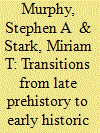| Srl | Item |
| 1 |
ID:
157734


|
|
|
|
|
| Summary/Abstract |
Across the Theravada Buddhist countries of Southeast Asia, the Vessantara Jataka has long been the most famous of the stories (jatakas) of the previous lives of the Buddha. However, little attention has been paid to the jataka's historical vicissitudes. Drawing on comparisons with neighbouring Thailand, this essay suggests there have been significant differences in the jataka's performances and interpretations in Burma (Myanmar), Cambodia and Laos. This essay seeks to historicise understandings of the Vessantara Jataka, showing how social movements, state policies and global pressures have shaped understandings of the jataka differently in each country.
|
|
|
|
|
|
|
|
|
|
|
|
|
|
|
|
| 2 |
ID:
147664


|
|
|
|
|
| Summary/Abstract |
Studies of early Southeast Asia focus largely on its ‘classical states’, when rulers and their entourages from Sukhothai and Ayutthaya (Thailand), Angkor (Cambodia), Bagan (Myanmar), Champa and Dai Viet (Vietnam) clashed, conquered, and intermarried one another over an approximately six-century-long quest for legitimacy and political control. Scholarship on Southeast Asia has long held that such transformations were largely a response to outside intervention and external events, or at least that these occurred in interaction with a broader world system in which Southeast Asians played key roles. As research gathered pace on the prehistory of the region over the past five decades or so, it has become increasingly clear that indigenous Southeast Asian cultures grew in sophistication and complexity over the Iron Age in particular. This has led archaeologists to propose much greater agency in regard to the selective adaptation of incoming Indic beliefs and practices than was previously assumed under early scholarship of the nineteenth and early to mid-twentieth century.
|
|
|
|
|
|
|
|
|
|
|
|
|
|
|
|